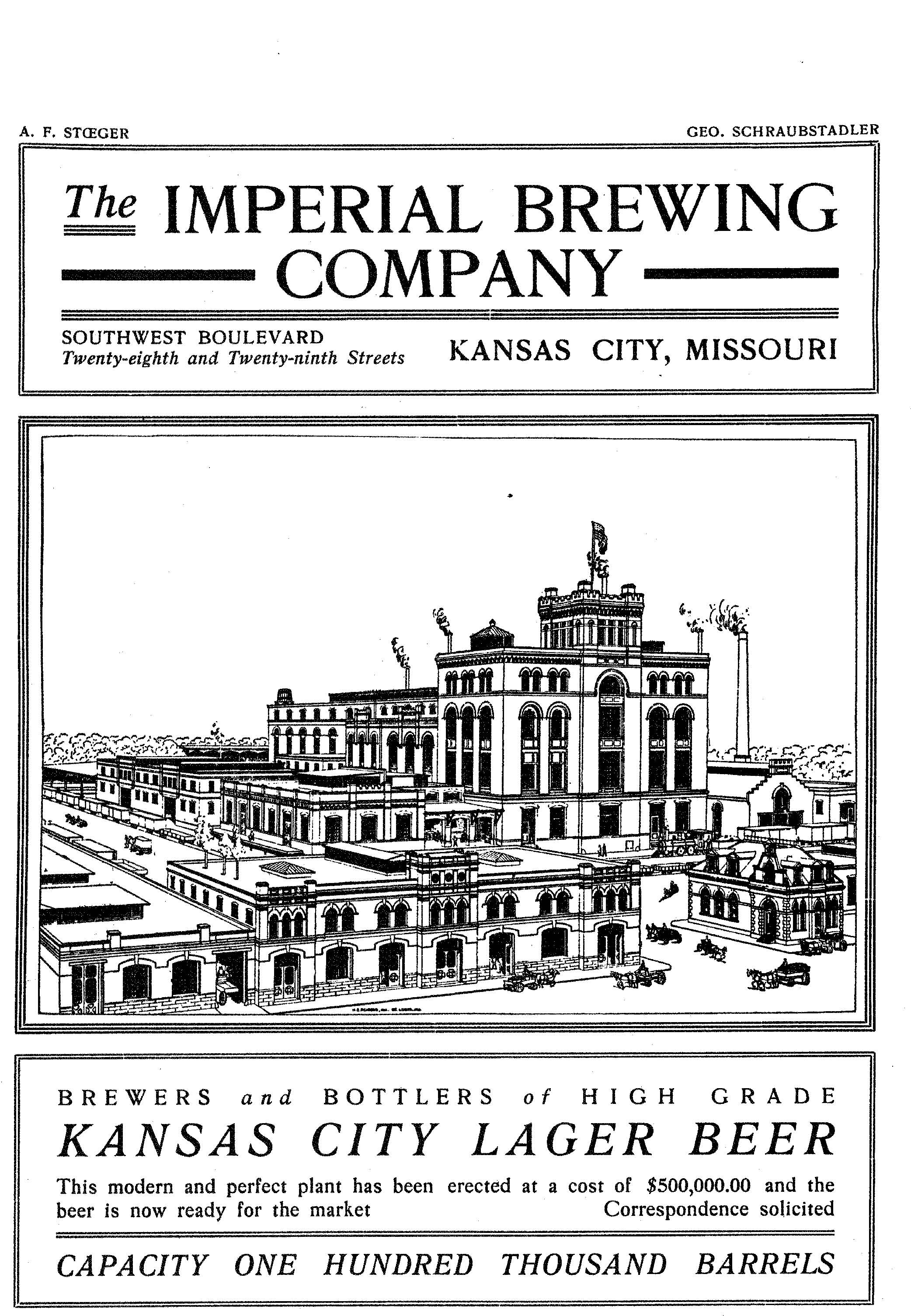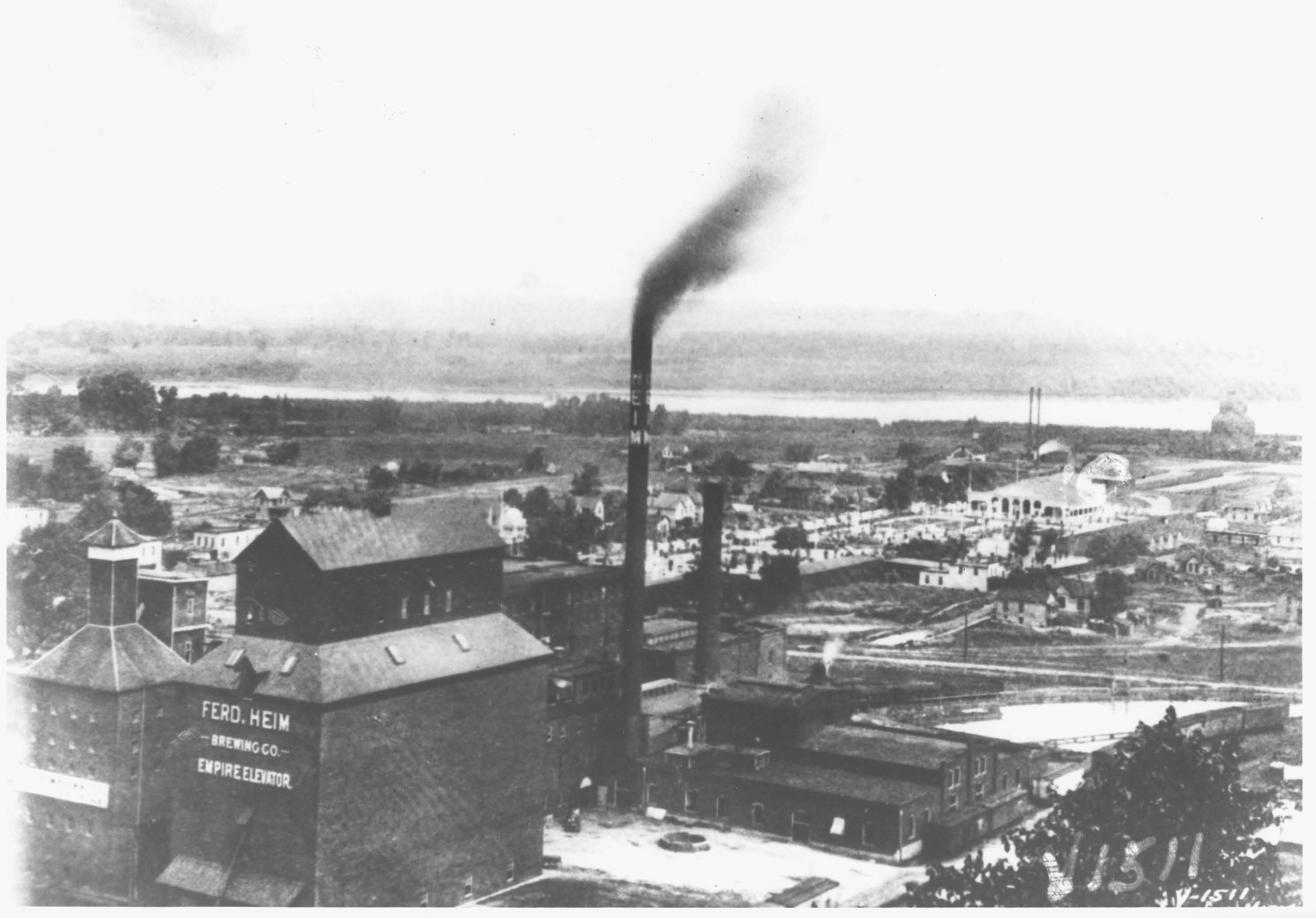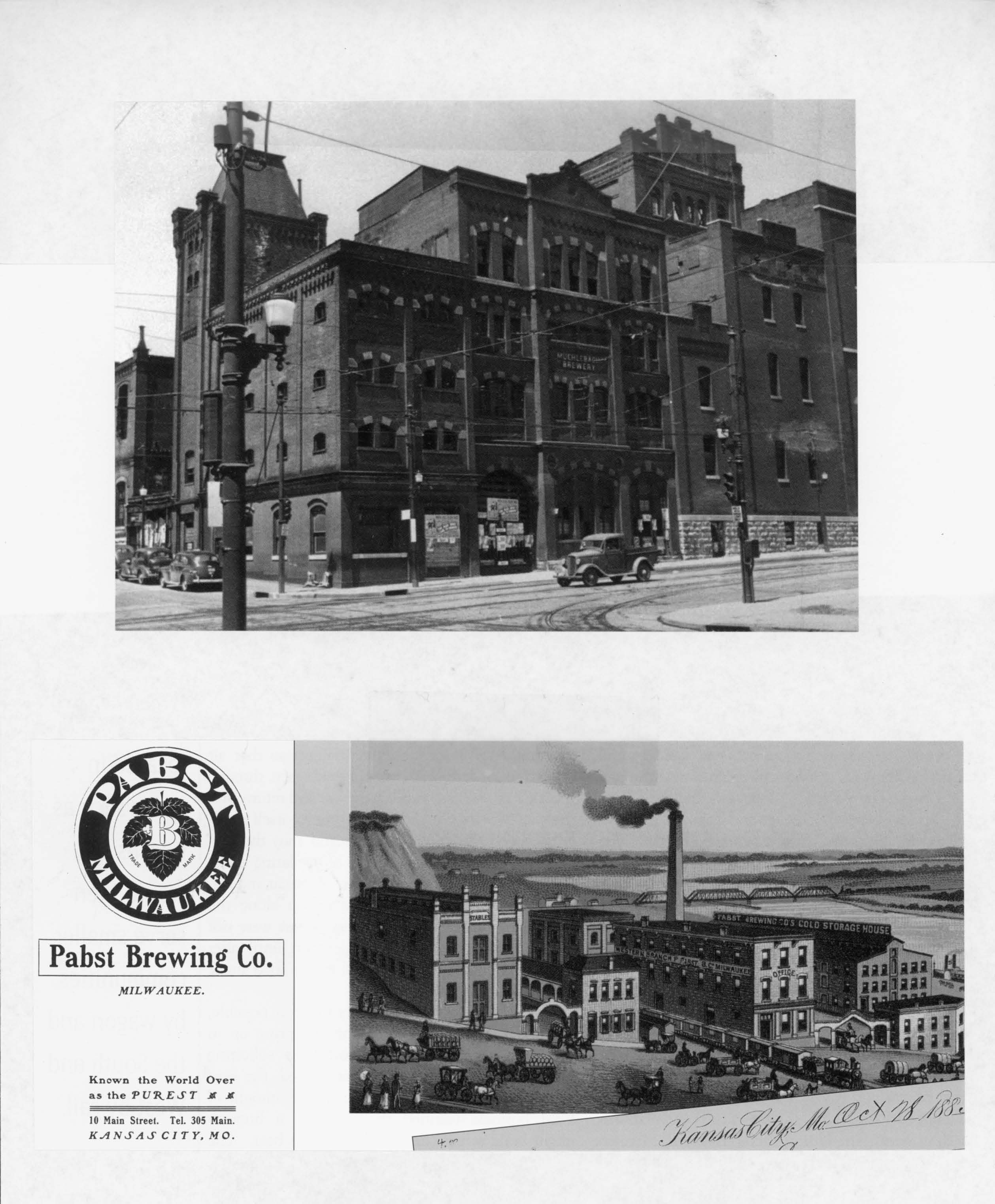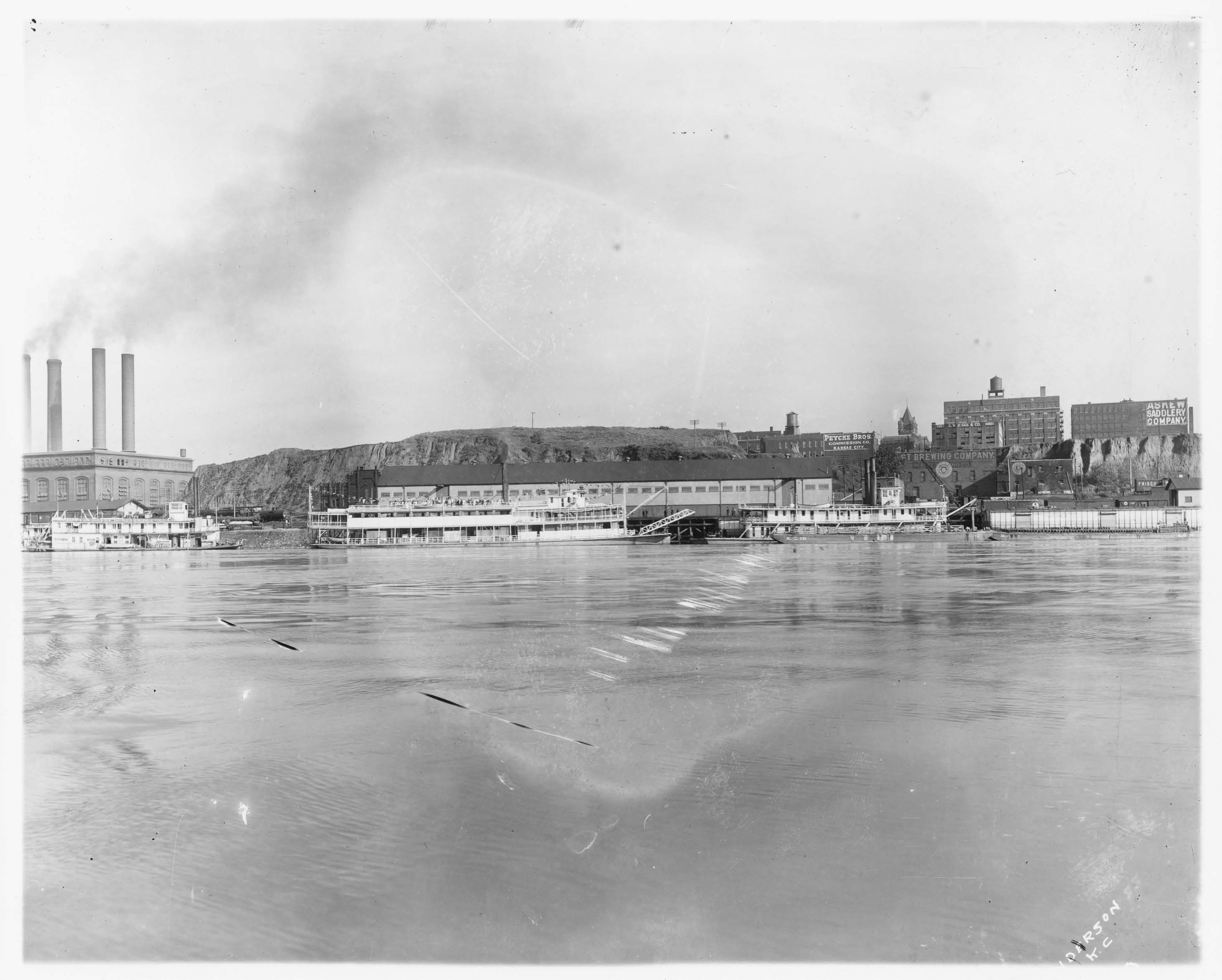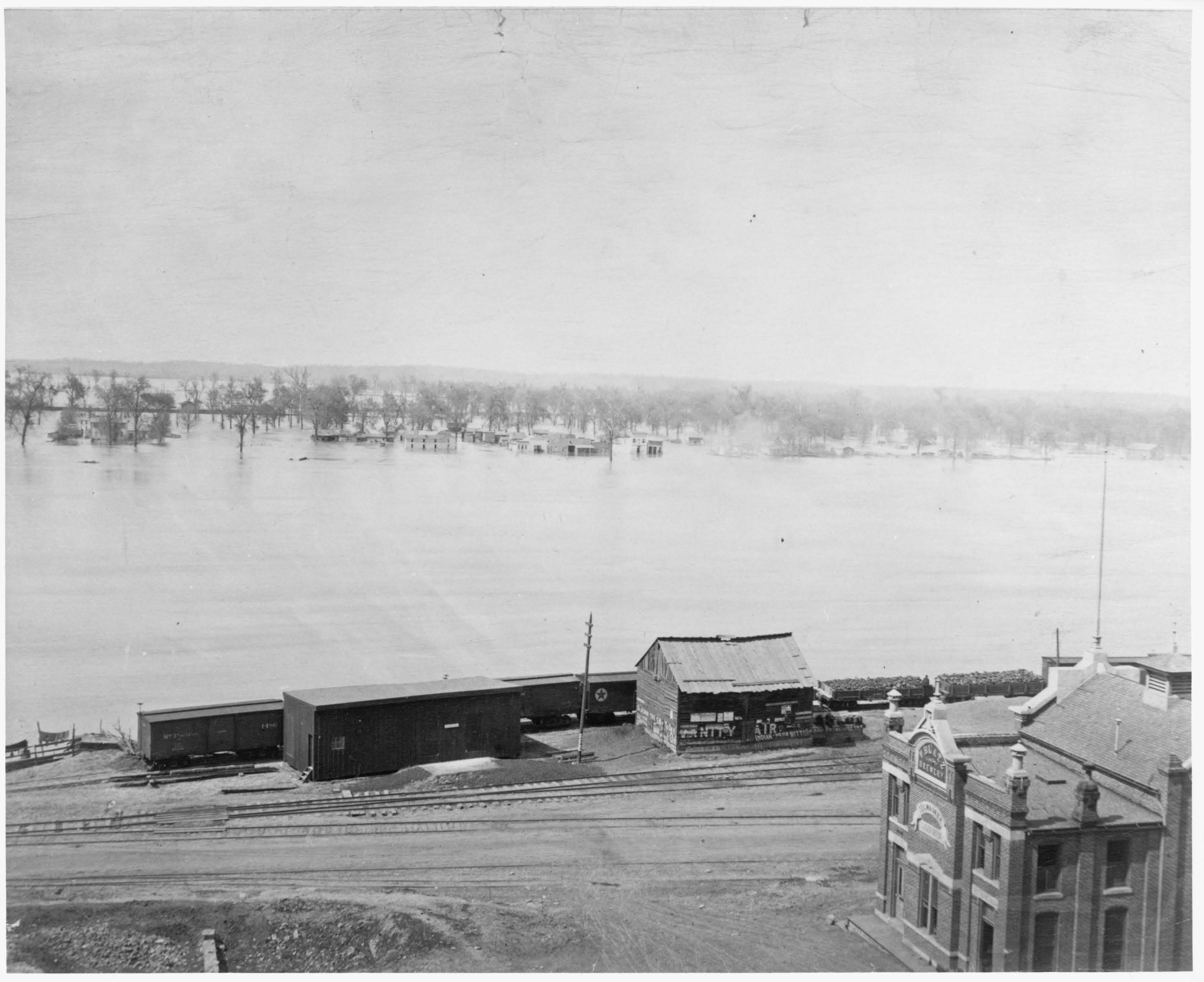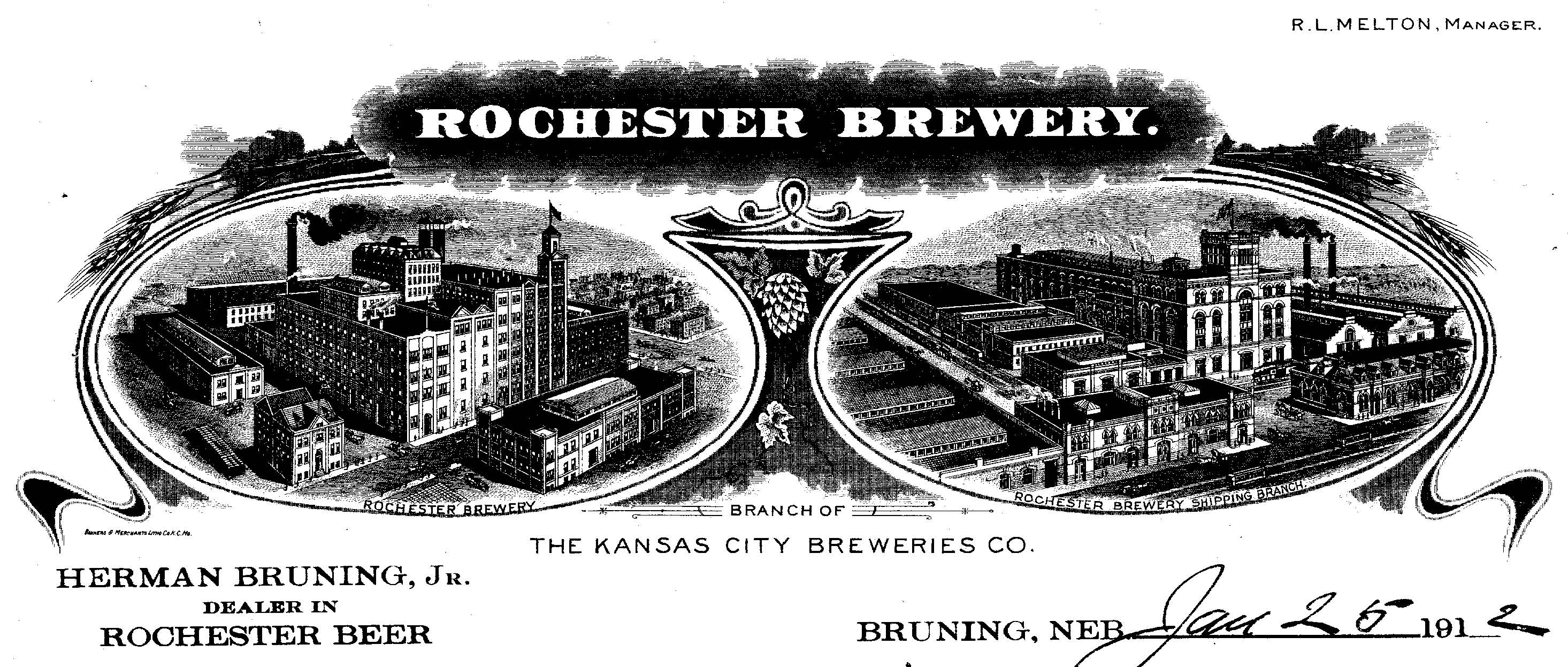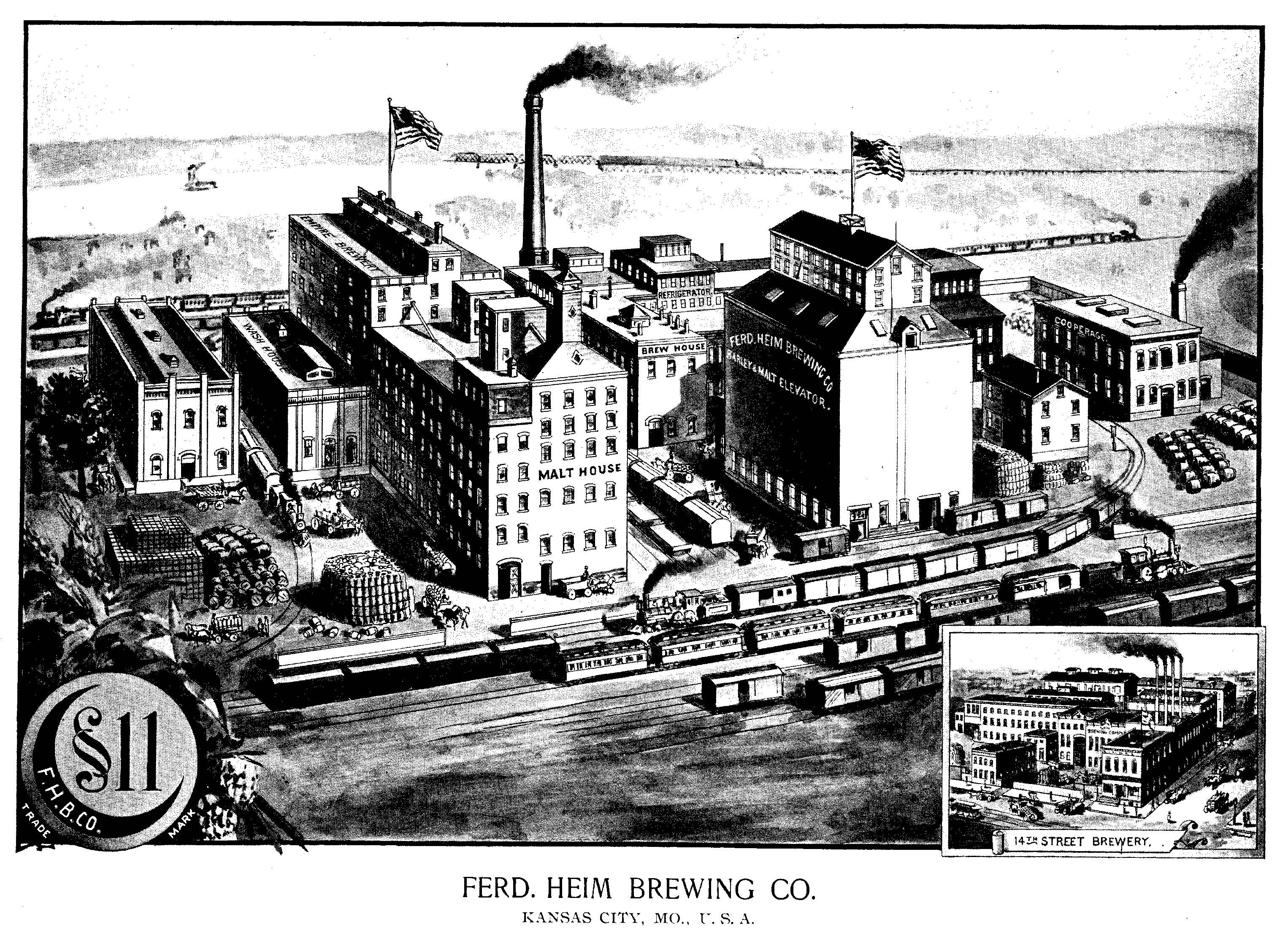DRIVING TOUR OF KANSAS CITY'S HISTORIC BREWERIES
Download and Print the Images Handout for the Driving Tour
Scroll down to view the Driving Tour Images
During the tour we will visit the existing structures of the Imperial (1901), Leo Thoma, Ferd Heim (including the original Electric Park), Muehlebach (later Schlitz), Lemp (depot), Pabst (depot), Imperial (1933), Rochester, and Schlitz (1880 depot) breweries. It will also pass by other brewing landmarks in the city, including what was described as the “wettest block in the world.”
This driving tour of Kansas City’s still-standing breweries and brewery related structures starts from Union Station. Proceed West on Pershing Rd. to the third stop light (West Pennway) and turn right. Go north to Southwest Blvd. (just after 21st Street). Turn left on Southwest Blvd. and go south.
Basically the brewery related structures were located in the East Bottoms, Levee Street along the river, the City Market area, the West Bottoms, and in the rail district around Union Station.
In addition to the breweries that were located here, various out of town breweries built depots and branches here to handle their beer. Initially an agent took orders for delivery by rail road. If volume warranted a “depot” would be built, which included an icehouse and stables, or a “branch” would be built if circumstances justified a bottling operation.
The first was Dick & Brother from Quincy, IL in 1873. Remember the railroad bridge across the Missouri River was built in 1869. The Milwaukee breweries were next—Pabst in 1879, Schlitz in 1880 and Val Blatz in 1880. Pabst had opened its first depot in Chicago in 1878. Kansas City was its second. Then came the St. Louis breweries—Anheuser Busch in 1884, Green Tree in 1885 and Lemp in 1893. In 1895 Lemp moved into the striking building at 20th and McGee, which we will see later.
The development of these “national breweries” was made possible by: the development of pure yeast cultures making for a consistent product, pasteurization in 1870 (20 minutes at 170 degrees), stronger machine-made glass bottles, the crown bottle cap to replace cork stoppers, mechanical refrigeration to make ice (rather than cut it in the winter), an expanding national railroad system, and refrigerated rail cars (packed with ice in hoppers).
They came to Kansas City because of its population growth (in 1850 it was less than 5,000, by 1880 it was over 55,000 and by 1886 it was over 150,000), less competition than in cities with large German populations and more breweries (Milwaukee, Chicago and St. Louis), and its proximity to the State of Kansas, which had gone dry in 1881.
Royal Brewing Co., of Weston, MO, the oldest brewery in the area (1842), began officing out of Kansas City in 1901. At one time it sold excess electricity to nearby communitioes. M. K. Goetz Brewing Co., of St. Joseph, MO (1859), open a depot in Kansas City in 1906 and built a 100,000 barrel-per-year brewery here in 1936 at 17th and Indiana, the present site of the US Post Office processing center.
BOULEVARD BREWING CO.
The first brewery we will pass is Boulevard Brewery at 2501 Southwest Blvd. (It is covered in Chapter 17 of the book Hometown Beer—A History of Kansas City’s Breweries. Tours of the brewery are available Monday through Saturday. References herein are to chapters and pages in that book.)
LEO THOMA WEISS BEER BREWERY
And
IMPERIAL BREWING CO.
Drive south on Southwest Blvd. to 28th Street. Turn left on 28th Street, and stop at the first intersection.
The small building on your left, now covered with gray vinyl siding, is 1310 West 28th Street, and housed the Leo Thoma Weiss Beer Brewery from 1910 to 1919. Founded in 1898 as Bremer and Thoma to make soda pop, it had changed to Leo Thoma in 1910 when it moved to this location. Its weiss beer was a very populart premium product. During prohibition it went back to making soda pop and remained in that business until 1945. (pages 28-30)
Turn right into the alley, proceed south and stop even with the parking lot of Margarita’s Mexican Restaurant.
The rather imposing structure across the street and behind some buildings, on the bank of Turkey Creek, is the front portion of the first brewery in Kansas City to use the name Imperial Brewing Co. It was in business from 1901 until 1919 and had a capacity of 100,000 barrels per year. (Chapter 13) Handout page 1. In 1905 it merged with the Heim and Rochester breweries to form Kansas City Breweries Company (Chapter 14).
Because of the positioning of the freeway and some of the other buildings, it is hard to get a decent view of the buildings. By walking around the neighborhood you can find some slightly better views. Most of the brewery has been torn down, including the horse stables. The structure to the left (south) was the cooper shop and barrel storage.
PABST DEPOT
When ready to proceed turn right into the driveway along the south side of the red building to Southwest Blvd. and turn right. (If the driveway is blocked you and go straight down the alley and turn right onto Southwest Blvd.)
Drive north on Southwest Blvd.
Incidentally, look to the right when we pass 21st Street. That block running east from Southwest Blvd. is one of Kansas City’s few remaining cobble-stone streets. We will drive on another one a bit later.
Drive north (you will pass under two freeways) and one-half block after Broadway (just before 20th Street) pull to the right and stop.
The building to your right on the southeast corner of 21st and Central was a branch of Pabst Brewing Co., constructed in 1911. (page 79) Two additional stories have been added to the south part of the building. During Prohibition it was very active in the beer and whiskey business. After Prohibition it became Pendergast Distributing Company, which was owned by Tom Pendergast.
IMPERIAL BREWING CO.
Continue north on Southwest Blvd. (moving over into the left lane).
Just passed 20th Street, the green building on your left, at 122 Southwest Blvd., housed the second brewery in Kansas City to use the name Imperial Brewing Co. It was in business from 1933 to 1938. (pages 24 and 25) Unfortunately, the building has been extensively remodeled and nothing but the loading dock remains of its brewery days.
FERD HEIM BREWERY
Turn left at the next intersection (Baltimore) and drive north to 18th Street. Turn left on 18th Street and go west three blocks to Broadway. Turn right on Broadway and head towards down town. Just before you pass over the freeway turn right onto the ramp down to I-70 (labeled Truman Road). Drive east on I-70 to Benton Blvd. and exit to the right. At the bottom of the ramp go straight (north) on Benton.
You are going all the way to the 300 block of Benton. At Independence Avenue you will need to jog left and continue north.
Pull to the right and stop at Lexington Street. 320 Benton is on your left.
The two houses on your left belonged to the two of the three sons of Ferdinand Heim (1833-1895): 328 was Michael G. Heim and 320 was Ferdinand Heim, Jr. (later he also bought 318 Benton which he eventually gave to the church across the street).
Drive a little further and stop just before the next intersection (Anderson).
The corner house on your left at 300 Benton belonged to the third brother, Joseph J. Heim. They were the sons of Ferdinand Heim who had a brewery in East St. Louis from 1870 until 1889. In 1884 the family had purchased the Star Ale Brewery, owned by F. H. Kump, at 14th and Main St. (Where the Empire Theater is today.) In 1885[?] they also purchased a sugar mill in the East Bottoms, which they remodeled and expanded to become the Ferd Heim Brewery (which you will see in few minutes). They were the first in the city to own an automobile with a back seat and the first $1,000 donor to the Kansas City Museum.
Proceed two blocks to the roundabout and go all the way around (be careful of the inside curb) so you can drive south again on Benton and stop at Anderson and stop again at Lexington, so the people on the other side of the bus can see the houses.
Drive south to Independence Ave. and turn right. Drive three blocks, turn right on Chestnut Trafficway, and continue north. Stop on the overpass at the bottom of the hill, just past the last tree next to the road. There is a lane there where you can stop.
On your right are the remaining buildings of the once famous Ferd Heim Brewery. (Chapter 8) Handout page 2. What you see now was the malthouse and stockhouses #1 and #2. In 1897 it ranked in the top 50 breweries in the nation with a capacity of 350,000 barrels per year. It was the first in the city to have a private telephone exchange. The Heim family is credited with inventing the top-loading ice box (blocks of ice went in the top).
Proceed north on Chestnut about three blocks to just before the first intersection. You will be able to turn around in a parking lot on your right, and then drive south again on Chestnut.
On your left you will pass the Heim bottling house (more on this building later). As we drive north on this overpass you are riding above the site of the first Electric Park, which opened in 1899. Handout page 3. At that time lighting was still a novelty. John Philip Sousa band played for the opening. Among other things, it included a 2,500-seat theater, roller coaster, merry-go-round, bowling alley, reproduction of a German village, dance pavilion, and, of course, a beer garden. The beer was piped directly from the brewery. In addition to thousands of electric lights it had a lighted fountain where a woman, dressed only in a gossamer costume, rose on a pedestal out of the center. Ferd Heim built an electric streetcar, which ran from the City Market to the park, using electricity supplied by the brewery. Soon we will be passing over the route taken by that streetcar. Special excursion trains from all over MO and KS brought people to the park.
The second Electric Park, a 27-acre facility at 46th and Paseo, opened in 1907, on the site of what is now the Village Green Apartments. It survived a fire in 1925, and operated until 1934, when a second fire brought an end to “Kansas City’s Coney Island.” Decorated with over 100,000 electric lights, it included a boardwalk, scenic railroad, balloon ascent ride, water chute, roller skating rink, shooting gallery, penny arcade, dime museum, billiard hall, boating and swimming lake, alligator and crocodile exhibit, dance pavilion and, of course, a beer garden.
When you get back up on the overpass watch for a ramp to you right. Turn right on the Guinotte exit ramp. At the bottom of the ramp continue bearing right until you reach the stop sign. Proceed straight across Guinotte and continue north for one block. Turn right, just before the railroad tracks, into the gravel parking lot and pull forward to the center of the lot and stop.
The building in front of you, at 507 Montgall, is the bottling department building for the Heim brewery constructed in 1901. It had a capacity of 3,000 cases or 36,000 bottles per day. Beginning on page 138, there is an interesting story about its cornerstone (located at the southwest corner). Note the crescent moon at the center roof line. The §11 symbol means, “you will consume again,” in other words, “try it and you will like it.”
Next turn right on Montgall and drive south to the corner and stop.
The building ahead and to your left on the southeast corner of that intersection is the Heim #20 Fire Station, built in 1902. (page 129)
Turn left and drive east on Guinotte, passing under the overpass. Follow the road curving first to the right and then back to the left. Pull into the second parking lot on your left (if the gate is open) where you will have a good view of the buildings and stop. If the gate is not open drive on past to where you can turn around.
The gray painted and red brick buildings are the remaining buildings of the Ferd Heim Brewery (Chapter 8). This brewery operated under that name from 1887 to 1905, when it became part of the Kansas City Breweries Company (Chapter 14), meging with the first Imperial and Rochester breweries. It continued under that name until the advent of Prohibition in 1919. Many of the buildings have been torn down and some painted gray, but you can easily detect the older brick buildings that were part of the original brewery.
Circle around in the parking lot and drive back west on Guinotte.
MUEHLEBACH BREWERY
Drive west on Guinotte 9/10ths of a mile to Lydia Avenue (which is just after you pass under the overpass). Turn left on Lydia and follow it up the hill. Stay on this somewhat winding road for 7/10ths of a mile to Locust (just after you pass under the freeway). You will notice that the street you are traveling on has become 3rd Street.
You are driving on the route of the streetcar line that ran from the City Market to Electric Park.
Turn left on Locust and go south two blocks to 5th Street. Turn right on 5th Street and drive one block to Oak. Turn right on Oak and head north back to 3rd Street.
The buildings on both sides of Oak between 3rd and 5th Streets, were part the George Muehlebach Brewing Co. from 1936-1956 (Chapter 4). Unfortunately, the brewhouse, which was on the southwest corner of 3rd & Oak, has been torn down. The pictures on pages 47 and 50-51 will help get you oriented.
In the 1860s George and John Muehlbach had initially purchased the George Hierb Brewery at 18th and Main St., which they operated until the advent of prohibition in 1919. Handout page 4. Over the years it was expanded, ultimately to a capacity of 100,000 barrels per year. Other members of the family were in the hotel, grocery and funeral home business.
Following the repeal of Prohibition the family had trouble obtaining the financing to open a new brewery. This new facility was finally opened in 1938, and by 1955 the capacity had been expanded to 500,000 barrels per year. In 1956 it was sold to Schlitz, which brewed at this location until 1973. The Schlitz brewery was known locally for the many social gatherings which took place in its famous Brown Bottle Room and for its sponsorship of the Kansas City Athletics baseball team.
At the stop sign turn left on 3rd Street.
GREEN TREE DEPOT
Unfortunately in 2004 the city tore down the Green Tree Brewing Co. depot to create more parking for City Market. It operated at 201 Grand from 1893 until 1911.
Continue west on 3rd Street four blocks to Main and turn right. Stop at the bottom of the hill at 2nd Street.
This area was once alive with breweries. Peter Schwitzgebel had a brewery in the late 1850s at 3rd and Oak. Helmreich & Raffaletti had a brewery on East Commercial in the 1850s. Commercial is that street between 1st Street and Levee. Helmreich & Messerschmitt (new partner?) had a brewery on East Levee in the 1860s named Pacific Brewery. Pacific moved from this location to 23rd & Westport Rd., and went out of business sometime around 1873.
Levee was the street running along the south bank of the river. It is no longer accessible by automobile, but can be reached using the pedestrian walkway at the base of Main Street. None of the buildings survive today, although there are still some foundations of old warehouses. See pages 10 for an artist drawing of the levee area around 1855.
Most importantly, two important out-of-town breweries had their branches near Levee at the foot of the bluff.
The Pabst branch was established on Main Street in 1879, ultimately extending for two blocks from 2nd Street to Levee. In 1911 it mover from here to the location we saw earlier. In other words it ran along the west side of Main from Levee, at the bottom of the hill, up past Commercial, where the railroad tracks are now, to 2nd Street. Bottom picture handout page 4.
The Val Blatz depot was located on the east and west sides of Walnut at Levee from 1880 until Prohibition in 1919. Handout pages 5 and 6. On page 5 Val Blatz to left of long building and Pabst to its right. Page 6 is Val Blatz in the lower left.
Turn left on 2nd Street, drive west one block to Delaware and turn left. Stop just past 3rd Street.
The beautiful building at what would be 304 Delaware was once the depot of George Wiedemann Brewing Co. of Newport, Kentucky.
F. H. KUMP BREWERY
Drive south on Delaware, past the point where it merges with Main Street. Turn left at 14th Street.
A brewery once occupied the site of what is now the Empire Theater, on the southwest corner of 14th & Main. F. H. Kump and his partner purchased the property in 1867, and relocated their broom, soda water and root beer business there. At that time they were only bottling beer for others. In 1869 they began brewing their own beer. The beer was a great success, necessitating the continual expansion of the brewery, which eventually expanding almost to 15th Street. By 1884 they were producing 12,000 barrels a year. That year the brewery was sold to the Heim family, formerly of East St. Louis. (pages 14-16) The Heim family increased production to 48,000 barrels per year. After they opened the facility in the East Bottoms in 1887 this location was renamed Bavarian Brewing Co. (page 14)
WM. J. LEMP DEPOT
Drive east on 14th Street, through the Power & Light District, to Grand Ave. Turn right on Grand Ave. and go south to 18th Street. Turn left on 18th Street and drive east to McGee. Turn right on McGee. Drive south on McGee and stop just before the intersection with 20th. Turn right on 20th and stop again.
At 215 East 20th Street sits the beautifully restored depot of Wm. J. Lemp Brewing Co. of St. Louis, built in 1895 (Chapter 12). This building is now the home of the McKay and Beyerley law firm.
ANHEUSER BUSCH BRANCH
Continue west on 20th Street nine blocks to Washington.
Nothing remains today, but from 1883 until Prohibition in 1919 Anheuser Busch had a branch on the east side of Walnut stretching north from 20th Street eventually almost reaching to 19th Street. Excellent pictures appear on pages 96-97.
ROCHESTER BREWING CO.
Turn left on Washington and stop.
In the middle of the block on the east side of the street, at 2015 Washington, is a large brick building which was the bottling department of the once great J.D. Iler Brewery, later the Rochester Brewing Co. The brewery had a capacity of 125,000 barrels per year. (Chapter 11) Handout page 7. The building on the right is Imperial.
Rochester operated at this location from 1888 to Prohibition in 1919. In 1905 it joined the first Imperial and Heim breweries to become Kansas City Breweries Co. operating at all three locations.
Though there has been some remodeling, it is still possible to see the original foundation and where a door was bricked in. There are wooden columns, visible through the loading dock doors on the north side of the building, if they are open. The brewery itself, none of which remains today, was located all along the west side of the street from 20th to 21st Street.
“WETTEST BLOCK IN THE WORLD”
Continue south on Washington and at West Pennway (21st Street) turn left. Turn left again on South West Blvd. And immediately turn left again on Broadway. Drive north to 12th Street and turn left. Stay on 12th Street down into the West Bottoms and proceed straight ahead up the ramp, following it around the curve to the right, and back down (it is now called James Street). Continue north and turn right on Central Avenue. Drive east on Central two blocks to State Line, and stop.
The building to your left, with the numbers 724 above the door (actually 1724 West 9th), was once James Flanagan’s Place, which is described and pictured on the first page of the Preface to our book. James Flanagan was Bob Sullivan’s great grandfather. What lies ahead of you was once described as “the wettest block in the world.” It stretches from State Line east to Genessee along 9th Street. At one time, 23 of the 24 buildings in this block were either saloons or liquor stores. There is a picture of the north side of this block on page 193. When Kansas adopting state wide prohibition in 1881 it became necessary for workers west of this point to cross over State Line at the end of the day to quench their thirst. An elevated rail line ran down the center of 9th Street and a station was located above this intersection at State Line. Hence this block was a rather popular meeting for the many who frequented its establishments all those years. Numerous speakeasies were located in this neighborhood during Prohibition. Speakeasies were always located on streetcar lines. Why? During Prohibition, few people owned a car. Kansas City was home to over 225 speakeasies.
Sadly only three of the original buildings remain today. One is a liquor store and up until a few years ago the other, located in the center of the block on the south side, was a bar. You can still see the Pabst Beer logo in the tile doorstep of the front door. This was what was called a “tied house.”
UTE DISTILLING CO.
Next, turn right on State Line and drive south one-half block to 925 State Line and stop.
The red brick building was the home of Ute Distilling Co. in 1914, the bottler of “Old Lagerbusch” brand beer, which was a very good beer. (page 22) Not much history, but at least the building has survived.
SCHLITZ BEER BRANCH
(Watch out for the holes in the road around the railroad tracks.)
Drive about one-half block further to a small red brick building on your left at 955 State Line, and stop.
This brick building, which was once an icehouse (page 160), and is all that remains today of the Joseph Schlitz Brewing Co. branch, located here from 1880 to 1919. It was a massive complex, ultimately stretched south from 955 State Line to St. Louis Avenue and around the corner, where its stables and cooper shop fronted on St. Louis Ave. (Chapter 9)
BARRETT & BARRETT BOTTLERS
At the end of the street, turn left on St. Louis Avenue. Just make a hard turn left, and you are on St. Louis Ave. Go east three blocks and stop just beyond the intersection with Liberty Street.
Just beyond the intersection is an attractive building at 1422 St. Louis Avenue which once housed Barrett and Barrett, a maker of all kinds of ciders, vinegars, and a bottler of beer. At one time Kansas City was known for manufacturing cigars. Barrett and Barrett served as the American agent for Carling & Co., a Canadian brewer of ale, porter and stout. In 1880 Carling purchased a brewery in Cleveland, Ohio and Barrett and Barrett set up depots in Baltimore, Chicago, Peoria, St. Paul and Kansas City, where it had distribution facilities. In 1891 Barrett and Barrett purchased the Cleveland brewery and renamed it Barrett Brewing Co. They sold it in 1898.
DIRECTIONS BACK TO UNION STATION
Continue east on St. Louis Avenue to Hickory and turn right. Proceed south towards 12th Street. One block past 12th Street turn right on 13th Street. Go west one block and turn right on Liberty (unmarked). Drive north one block and turn right onto the up-ramp of 12th Street. Continue east on 12th Street to Broadway. Turn right on Broadway and drive south. Stay on Broadway as it turns into West Pennway. Continue on to Pershing Rd. and turn left. Proceed east on Pershing to the Union Station.
It is time to go home now and, in the spirit of this tour, have a cool one.
MORE ADVENTURES
For those of you that are in the mood for a little more adventure or can’t get enough of this stuff, check out the following:
(a) A building at 811 Sante Fe was the office and warehouse for Hamm Brewing Co. (St. Paul, MN) from 1910 to 1917, when it moved to 1323 West 9th Street (no longer standing).
(b) A building occupied by Frank J. Quigg Brewery from 1913 to 1915 is located at 1700 Madison (five blocks west of Broadway).
(c) A building occupied by Lion Brewing and Bottling Co. in 1903 is located at 2940 Fairmont (one block east of Southwest Boulevard).
(d) A faded sign advertising Heim beer can be seen on the side of a building on Gillis (four blocks east of Cherry), just south of Missouri Avenue (one block south of 5th Street).
